牛津译林版(2019)选择性必修二Unit4 Exploring literature Integrated skills 课件 (共23张PPT,内镶嵌视频和音频)
文档属性
| 名称 | 牛津译林版(2019)选择性必修二Unit4 Exploring literature Integrated skills 课件 (共23张PPT,内镶嵌视频和音频) | 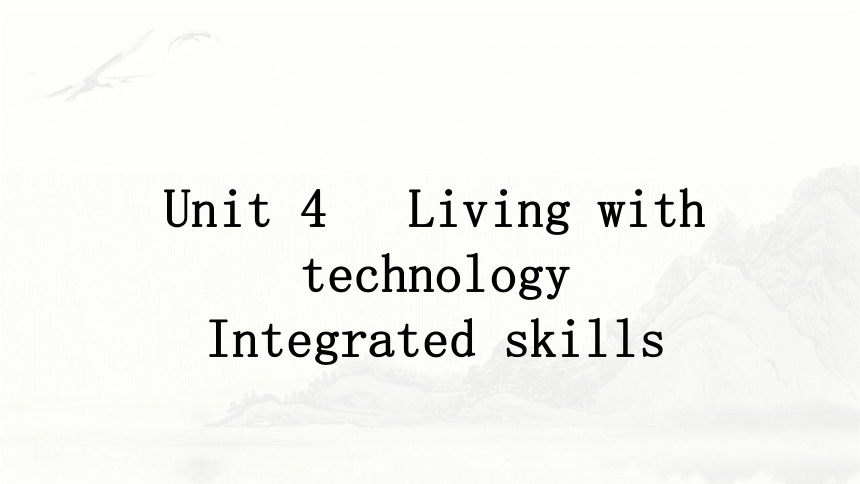 | |
| 格式 | pptx | ||
| 文件大小 | 34.3MB | ||
| 资源类型 | 教案 | ||
| 版本资源 | 牛津译林版(2019) | ||
| 科目 | 英语 | ||
| 更新时间 | 2024-03-21 09:55:15 | ||
图片预览

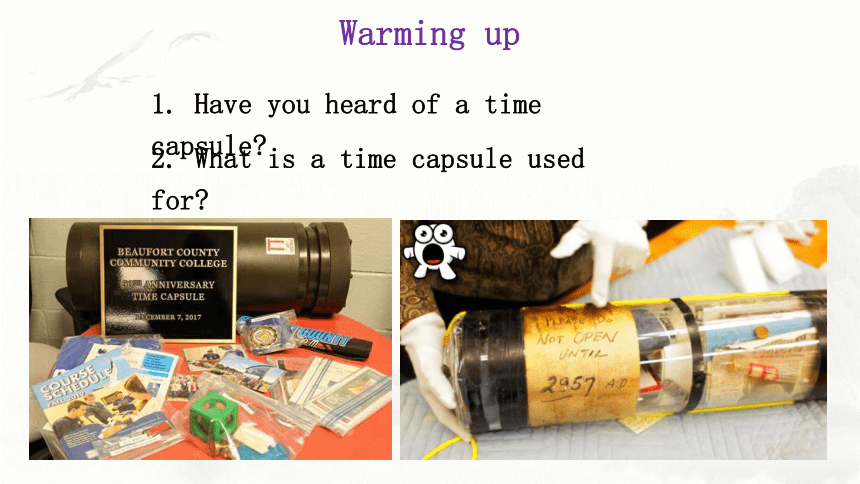
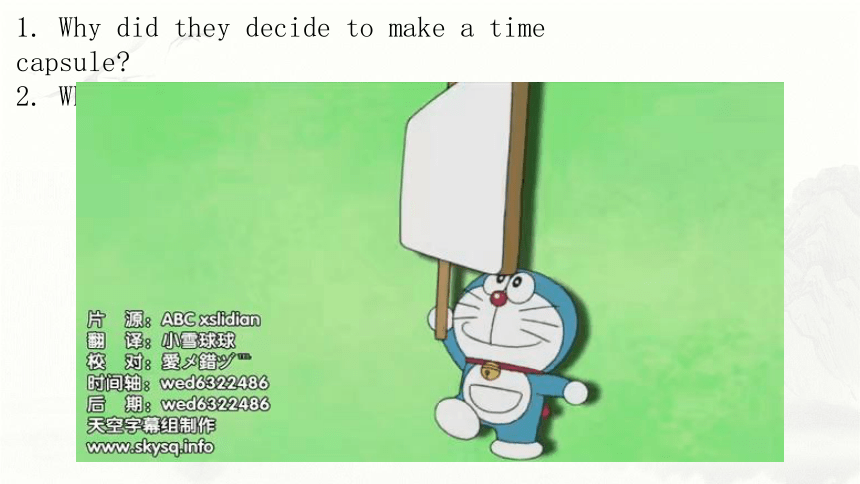
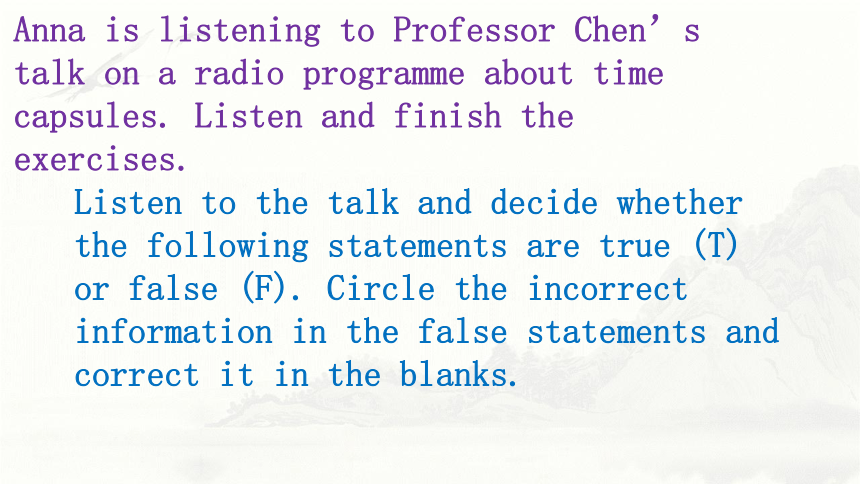
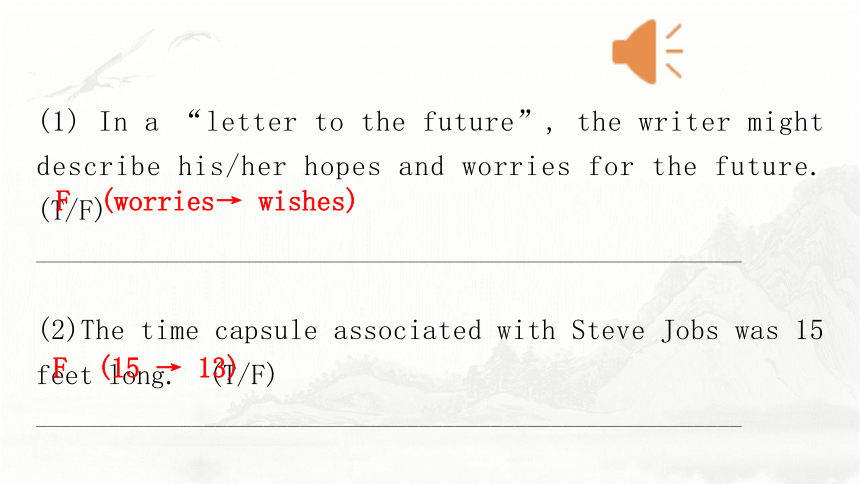
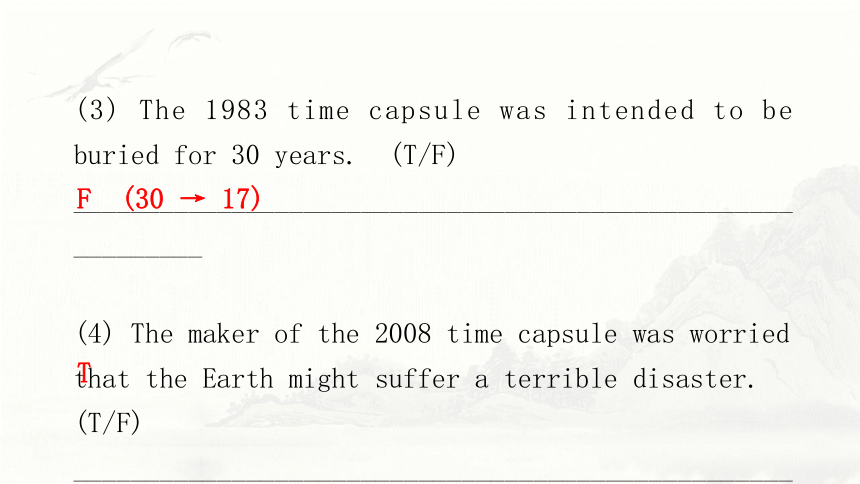
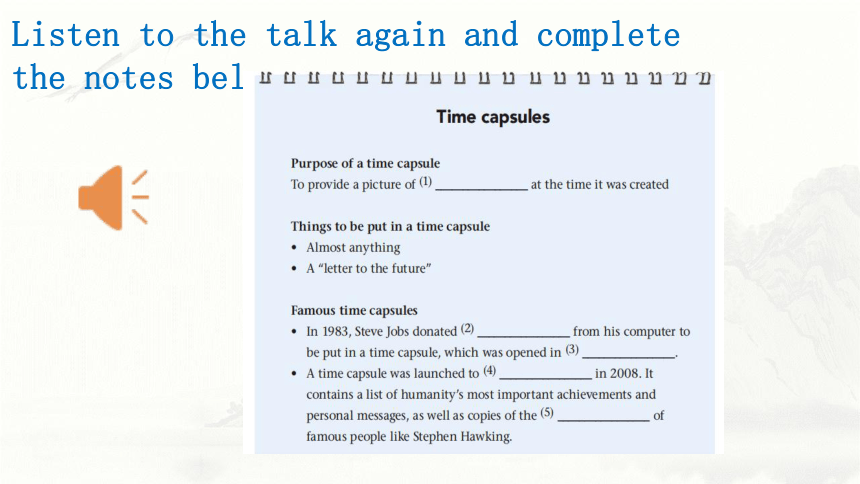
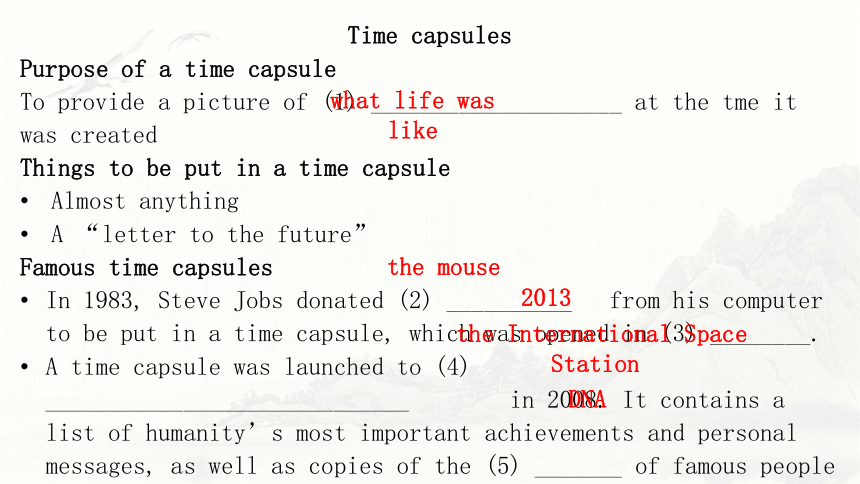
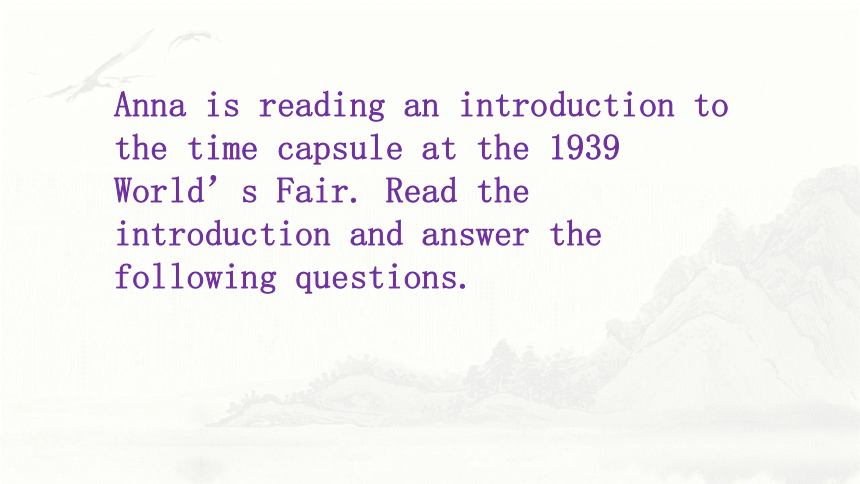
文档简介
(共23张PPT)
Unit 4 Living with technology
Integrated skills
Warming up
1. Have you heard of a time capsule
2. What is a time capsule used for
1. Why did they decide to make a time capsule
2. What did they put in the time capsule
Anna is listening to Professor Chen’s talk on a radio programme about time capsules. Listen and finish the exercises.
Listen to the talk and decide whether the following statements are true (T) or false (F). Circle the incorrect information in the false statements and correct it in the blanks.
(1) In a “letter to the future”, the writer might describe his/her hopes and worries for the future. (T/F)
___________________________________________________________
(2)The time capsule associated with Steve Jobs was 15 feet long. (T/F)
___________________________________________________________
F (worries→ wishes)
F (15 → 13)
(3) The 1983 time capsule was intended to be buried for 30 years. (T/F)
___________________________________________________________
(4) The maker of the 2008 time capsule was worried that the Earth might suffer a terrible disaster. (T/F)
___________________________________________________________
F (30 → 17)
T
Listen to the talk again and complete the notes below.
Time capsules
Purpose of a time capsule
To provide a picture of (1) ____________________ at the tme it was created
Things to be put in a time capsule
Almost anything
A “letter to the future”
Famous time capsules
In 1983, Steve Jobs donated (2) __________ from his computer to be put in a time capsule, which was opened in (3) ________.
A time capsule was launched to (4) _____________________________ in 2008. It contains a list of humanity’s most important achievements and personal messages, as well as copies of the (5) _______ of famous people like Stephen Hawking.
what life was like
the mouse
2013
the International Space Station
DNA
Anna is reading an introduction to the time capsule at the 1939 World’s Fair. Read the introduction and answer the following questions.
1. What were the purpose and contents of the 1939 time capsule
To show the people living in the year 6939 what life was like in America at the time the capsule was created. The time capsule contained a wide variety of objects, including a toothbrush, a fountain pen, microfilm rolls and a message written by Albert Einstein.
2. What was Einstein’s message to future generations about Why do you think he wrote the message with mixed feelings
It was about the technological progress man had made and Einstein’s predictions that future generations would read his message with feelings of pride and justified superiority.
He felt a mixture of pride and worry probably because on the one hand, America had achieved many great things unimaginable to people in the past, but on the other hand, serious social problems were developing in his time.
In pairs, discuss ideas for your time capsule that will be opened in 2050 with the help of the questions in Part C on Page 52 to make up a dialogue.
What would you like to tell people in the future
Imagine that you need to put a technological product in the time capsule. What would you choose Why
What hopes and wishes do you have for the future
1 The time capsule, buried 50 feet below the ground in a park,…
bury v. 1) to put something under the ground, often in order to hide it 埋藏
2) to put someone who has died in a grave
埋葬,安葬
3) to put sth deeply into sth else 陷入
bury oneself in sth. 专心致志于某事
bury one's head/face in one's hands 双手抱头/掩面
bury one's head in the sand自欺欺人;逃避现实
burial n. 埋葬;葬礼
练习:He buries himself ________ his work every day.
2. conclude
conclude… with… 以……结束……
conclude sth by doing… 以做……结束某事
conclude… from… 从……中推断出……
conclude(from…) that... (从……)推断出,断定……
It is concluded that... 结论是……
conclusion n.结论;结束
arrive at/come to/reach/draw a conclusion (that.…) 得出(……)结论
in conclusion 最后;结论是
jump to the conclusion (that...) 贸然断定(……)
conclusive adj.结论性的;不容置疑的;确凿的
练习:Some people jumped hurriedly to the ___________ (conclude) that something must be wrong.
conclusion
3. engage
engage in sth 参与某事
engage sb in sth(使)某人从事/参与某事
engaged adj.忙于;从事于;已订婚的;被占用的;使用中的
get/be engaged in sth 忙于某事
be engaged to sb 跟某人订婚
engagement n.订婚;婚约
练习:They are __________ (engage) in talks with the government.
engaged
4. annoy
annoyed adj.恼怒的;生气的
be annoyed at/with sb about/by sth 因某事对某人生气
be annoyed that...对……感到生气
annoying adj.令人生气/烦恼的
annoyance n.烦恼;令人烦恼的事物
练习:He got very __________ (annoy) with me about my carelessness.
annoyed
Write a letter to people in 2050. Use your ideas from part C and the information in parts A and B to help you.
Planning your writing
Learning about the structure
When writing a letter to people in the future, follow the structure below:
Describe what life is like in your time.
Focus on one technological product and explain how it is changing people’s lives.
Conclude your letter with your hopes and wishes for the future.
Useful expressions
I want to tell you about…
I’m writing the letter to…
I’m writing to you for the purpose of…
The purpose of this letter is to…
I hope that…
I do hope that…
I’m looking forward to…
Looking forward to…
Hopefully…
moreover, in addition, besides, plus……
Learning about writing techniques
It is a good idea to give specific statements rather than general ones, which makes it easier to get your ideas across. For example:
We are living in a great age. (general)
We are living in an age when the Internet makes it possible for us to stay connected wherever we are. (specific)
A letter to people in 2050
Dear friends from the future,
Greetings from the past! We are currently living in an exciting time that is full of amazing discoveries, especially in science and technology. Some especially important technologies that we use today are the Internet and artificial intelligence, without which the smartphone would not be possible. I have placed a typical smartphone in the time capsule for you to see.
The smartphone is a relatively new invention, but these days people could hardly live without it. It is extremely important for most people because it makes our lives more interesting and convenient. We use the smartphone for many things besides messaging and calling, such as surfing the Internet, shopping online, and using virtual directions. I also have a lot of photos on it about my daily life, such as the food I eat, the clothes I wear and the sport I play. I wonder if you still use smartphones in the future or if you instead use some type of smart implant technology!
In the future, I hope that you will have a more balanced life with technology. I sometimes think that we rely too much on it. While I do not want to lose the advantages smartphones and other technologies bring, it would be nice for people to spend a bit less time using them. That is all for now! I hope you enjoyed seeing what life is like in my time!
Yours,
Jessie Chen
Unit 4 Living with technology
Integrated skills
Warming up
1. Have you heard of a time capsule
2. What is a time capsule used for
1. Why did they decide to make a time capsule
2. What did they put in the time capsule
Anna is listening to Professor Chen’s talk on a radio programme about time capsules. Listen and finish the exercises.
Listen to the talk and decide whether the following statements are true (T) or false (F). Circle the incorrect information in the false statements and correct it in the blanks.
(1) In a “letter to the future”, the writer might describe his/her hopes and worries for the future. (T/F)
___________________________________________________________
(2)The time capsule associated with Steve Jobs was 15 feet long. (T/F)
___________________________________________________________
F (worries→ wishes)
F (15 → 13)
(3) The 1983 time capsule was intended to be buried for 30 years. (T/F)
___________________________________________________________
(4) The maker of the 2008 time capsule was worried that the Earth might suffer a terrible disaster. (T/F)
___________________________________________________________
F (30 → 17)
T
Listen to the talk again and complete the notes below.
Time capsules
Purpose of a time capsule
To provide a picture of (1) ____________________ at the tme it was created
Things to be put in a time capsule
Almost anything
A “letter to the future”
Famous time capsules
In 1983, Steve Jobs donated (2) __________ from his computer to be put in a time capsule, which was opened in (3) ________.
A time capsule was launched to (4) _____________________________ in 2008. It contains a list of humanity’s most important achievements and personal messages, as well as copies of the (5) _______ of famous people like Stephen Hawking.
what life was like
the mouse
2013
the International Space Station
DNA
Anna is reading an introduction to the time capsule at the 1939 World’s Fair. Read the introduction and answer the following questions.
1. What were the purpose and contents of the 1939 time capsule
To show the people living in the year 6939 what life was like in America at the time the capsule was created. The time capsule contained a wide variety of objects, including a toothbrush, a fountain pen, microfilm rolls and a message written by Albert Einstein.
2. What was Einstein’s message to future generations about Why do you think he wrote the message with mixed feelings
It was about the technological progress man had made and Einstein’s predictions that future generations would read his message with feelings of pride and justified superiority.
He felt a mixture of pride and worry probably because on the one hand, America had achieved many great things unimaginable to people in the past, but on the other hand, serious social problems were developing in his time.
In pairs, discuss ideas for your time capsule that will be opened in 2050 with the help of the questions in Part C on Page 52 to make up a dialogue.
What would you like to tell people in the future
Imagine that you need to put a technological product in the time capsule. What would you choose Why
What hopes and wishes do you have for the future
1 The time capsule, buried 50 feet below the ground in a park,…
bury v. 1) to put something under the ground, often in order to hide it 埋藏
2) to put someone who has died in a grave
埋葬,安葬
3) to put sth deeply into sth else 陷入
bury oneself in sth. 专心致志于某事
bury one's head/face in one's hands 双手抱头/掩面
bury one's head in the sand自欺欺人;逃避现实
burial n. 埋葬;葬礼
练习:He buries himself ________ his work every day.
2. conclude
conclude… with… 以……结束……
conclude sth by doing… 以做……结束某事
conclude… from… 从……中推断出……
conclude(from…) that... (从……)推断出,断定……
It is concluded that... 结论是……
conclusion n.结论;结束
arrive at/come to/reach/draw a conclusion (that.…) 得出(……)结论
in conclusion 最后;结论是
jump to the conclusion (that...) 贸然断定(……)
conclusive adj.结论性的;不容置疑的;确凿的
练习:Some people jumped hurriedly to the ___________ (conclude) that something must be wrong.
conclusion
3. engage
engage in sth 参与某事
engage sb in sth(使)某人从事/参与某事
engaged adj.忙于;从事于;已订婚的;被占用的;使用中的
get/be engaged in sth 忙于某事
be engaged to sb 跟某人订婚
engagement n.订婚;婚约
练习:They are __________ (engage) in talks with the government.
engaged
4. annoy
annoyed adj.恼怒的;生气的
be annoyed at/with sb about/by sth 因某事对某人生气
be annoyed that...对……感到生气
annoying adj.令人生气/烦恼的
annoyance n.烦恼;令人烦恼的事物
练习:He got very __________ (annoy) with me about my carelessness.
annoyed
Write a letter to people in 2050. Use your ideas from part C and the information in parts A and B to help you.
Planning your writing
Learning about the structure
When writing a letter to people in the future, follow the structure below:
Describe what life is like in your time.
Focus on one technological product and explain how it is changing people’s lives.
Conclude your letter with your hopes and wishes for the future.
Useful expressions
I want to tell you about…
I’m writing the letter to…
I’m writing to you for the purpose of…
The purpose of this letter is to…
I hope that…
I do hope that…
I’m looking forward to…
Looking forward to…
Hopefully…
moreover, in addition, besides, plus……
Learning about writing techniques
It is a good idea to give specific statements rather than general ones, which makes it easier to get your ideas across. For example:
We are living in a great age. (general)
We are living in an age when the Internet makes it possible for us to stay connected wherever we are. (specific)
A letter to people in 2050
Dear friends from the future,
Greetings from the past! We are currently living in an exciting time that is full of amazing discoveries, especially in science and technology. Some especially important technologies that we use today are the Internet and artificial intelligence, without which the smartphone would not be possible. I have placed a typical smartphone in the time capsule for you to see.
The smartphone is a relatively new invention, but these days people could hardly live without it. It is extremely important for most people because it makes our lives more interesting and convenient. We use the smartphone for many things besides messaging and calling, such as surfing the Internet, shopping online, and using virtual directions. I also have a lot of photos on it about my daily life, such as the food I eat, the clothes I wear and the sport I play. I wonder if you still use smartphones in the future or if you instead use some type of smart implant technology!
In the future, I hope that you will have a more balanced life with technology. I sometimes think that we rely too much on it. While I do not want to lose the advantages smartphones and other technologies bring, it would be nice for people to spend a bit less time using them. That is all for now! I hope you enjoyed seeing what life is like in my time!
Yours,
Jessie Chen
